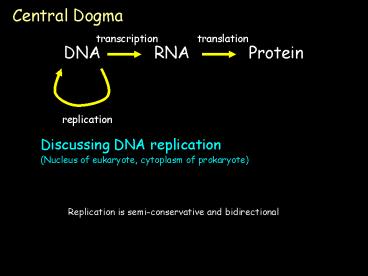Central Dogma - PowerPoint PPT Presentation
1 / 37
Title:
Central Dogma
Description:
Biochemistry of replication. DNA mutation and repair. Transcription. ECB 6-10 ... Biochemistry of replication. End replication problem. DNA mutation and repair ... – PowerPoint PPT presentation
Number of Views:79
Avg rating:3.0/5.0
Title: Central Dogma
1
Central Dogma
DNA
RNA
Protein
replication
Discussing DNA replication (Nucleus of eukaryote,
cytoplasm of prokaryote)
2
Lecture 10
DNA Replication
Leading and lagging strand synthesis
Biochemistry of replication
DNA mutation and repair
Transcription
3
DNA polymerase -adds nuclotides at 3 end of
existing strand
3 end
ECB 6-10
5 end
3 OH
Incoming nucleotide (triphosphate) adds at 3OH
of growing chain (condensation rx driven by
cleavage of PiPi)
Synthesis occurs in 5 - 3 direction
Specificity of which base adds depends on base
pairing with template strand ( strands are
complementary)
4
Problem Strands are antiparallel DNA made only
5 to 3
ECB 6-11
Fork moves at rate of 1000 nucleotides/sec in
prokaryotes (100 NTs/sec in humans)
5
Leading and lagging strands
Replication fork is asymmetrical
6
Lagging strand synthesis occurs from RNA primer
ECB 6-16
7
Other Proteins at Replication Fork
06.5-DNA_replication_fork.mov
ECB 6-17
Leading strand
Lagging strand
8
Lecture 10
DNA Replication
Leading and lagging strand synthesis
Biochemistry of replication
DNA mutation and repair
Transcription
9
Mutation a permanent change in DNA sequence
ECB 6-19
10
Mutations accumulate with age and cause cancer
Cancer loss of control of the cell cycle
Incidents of cancer per 100,000 women
ECB 6-20
Age (years)
11
Mutations and Repair
During Replication Incorrect nucleotide incorpora
ted
Post Replication Many sources of DNA damage
12
Mistakes during replication cause mutations
ECB 6-21
13
Proofreading
3 end
5 end
DNA Polymerase
polymerase
3 OH
-Catalyzes phosphodiesterbond formation
-Has exonuclease activity
Incoming deoxy-ribonucleoside triphosphate
-Performs proofreading
5 end
14
Proofreading mechanism
T
Exonuclease activity removes the incorrect
nucleotide
Polymerase activity then adds correct nucleotide
After proofreading, mistakes about 1/107
nucleotides
See ECB 6-13
15
Proofreading requires 5 to 3 DNA synthesis
Replication 3 OH
Replication 5 Triphosphate
PP
Energy from pyrophosphate
Energy from PP At 5 end
Error
Error
Incorrect dNTP removed
Incorrect dNTP removed
No PPP left At 5 end
3 OH available
Energy frompyrophosphate
Correct dNTPbut cannot beadded
Corrected!
ECB 6-15
16
Mutations and Repair
During Replication Incorrect nucleotide incorpora
ted
Post Replication Many sources of DNA damage
Causes of Errors Deamination Depurination Pyrimid
ine dimers
Post-replication repair also removes 99 of
errors made in replication Final error rate
1/109 NT
Cell mechanism to reduce proofreading
Cell mechanisms to reduce Many, involve
removing damaged DNA
17
Post-replication repair requires excision,
resynthesis, ligation
How damaged strand is recognized is not understood
ECB 6-26
18
Lecture 10
DNA Replication
Semi-conservative replication
Biochemistry of replication
End replication problem
DNA mutation and repair
Transcription
19
Central Dogma
DNA
RNA
Protein
Nucleus of eukaryote Cytoplasm of prokaryote
replication
ECB 7-1
20
What is a gene?
Double stranded DNA
Protein A
Protein B
Protein C
each gene contains the information required to
make a protein
21
How much of genome is composed of genes?
Genome Projects Bacteria - about 500 genes, most
of genome Eukaryotes - about 20,000-40,000 genes,
represents much less of genome
Humans - about 30,000 genes, only a few percent
of the total genome!!! Rest is repetitive DNA
sequences - junk DNA Much of repetitive DNA is
transposable elements that have mutated and can
no longer move 15 of human genome is the L1
element 11 is Alu sequence, about 300
nucleotide pairs
22
RNA Structure
DNA Structure Double stranded Double
helix Deoxyribonucleotides ATCG Organized as
chromatin
23
RNA Structure
ECB 7-3
24
DNA codes for RNA
Single-stranded product (5 to 3) Not H bonded
to DNA
RNA Polymerase
Coded by DNA template strand (also called
antisense strand)
25
Base pairing
Rate 30 NT/sec
26
4 major RNA classes
27
RNA Polymerases
Prokaryotes One RNA Polymerase, composed of four
subunits, plus additional factors that can confer
promoter specificity
Eukaryotes Three RNA Polymerases (RNA Pol I, II,
III), each composed of gt10 different proteins,
transcribe different types of genes.
RNA Pol. I synthesizes ribosomal RNA (rRNA)
RNA Pol II synthesizes mRNA (protein coding) and
some small RNAs.
RNA Pol III synthesizes a variety of small
RNAs, including tRNAs.
28
Lecture 10
DNA Replication
Semi-conservative replication
Biochemistry of replication
End replication problem
DNA mutation and repair
Transcription-general
Prokaryotes Eukaryotes
29
Prokaryotic Gene Organization
Most genes in Operons genes organized together,
with one shared transcription start site
One mRNA codes for Several proteins
ECB 8-6
30
Transcription Initiation in Bacteria - overview
RNA Polymerase contacts DNA, slides along strand,
looking for promoter sequences.
At the promoter, the RNA Polymerase binds
tightly, opening up a small single stranded
region.
31
Transcription Initiation in Bacteria (contd)
ECB 7-9
32
Initiation and termination of prokaryotic
transcription
ECB 7-9
33
Transcription termination in bacteria
ECB 7-9
Terminator (stop sequence)
RNA
Hairpin loop causes polymerase to fall off DNA
34
Genome of Mycoplasma genitalium
One of smallest genomes of any cell codes
for 470 proteins
How does the cell know where to transcribe? and
when to transcribe?
Proteins bind to specific DNA sequences, Some
activate transcription, some repress Termed
transcription factors
35
Gene regulation in prokaryotes
ECB 8-6
Regulatory protein (transcription factor) binds
operator
36
Repressible operon
Default state is on, can turned off
ECB 8-7
37
Inducible operon lac operon
Default state is off, turned on































